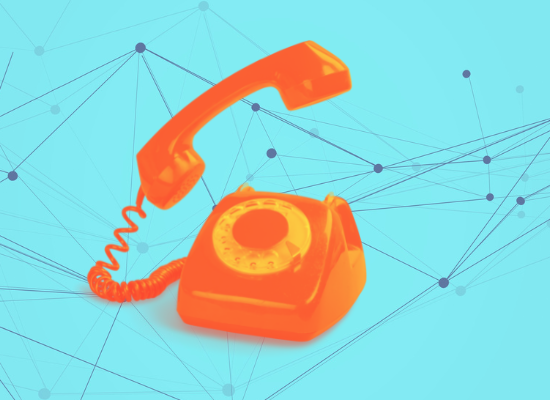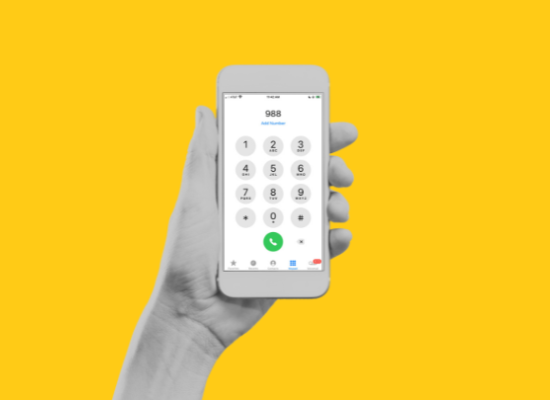
People in acute suicidal distress who reach out to the newly launched 988 Suicide and Crisis Lifeline (“988 Lifeline”) can often opt for a 988 crisis counselor to follow up with them within 24 to 72 hours after their initial outreach. The 988 Suicide and Crisis Lifeline provides free, confidential support via call, text, or chat to people experiencing a mental health, substance use, or suicidal crisis. The nationwide hotline’s best practice of offering follow-up services provides a vital opportunity for 988 crisis counselors to check on the person’s progress with their safety plan, inquire how the resources are working, and provide additional support as needed.
“It’s the right thing to do because we have seen that the situations underlying a crisis typically don’t disappear the next day,” reflects Megan Stone, MS, MHA, LPC, manager of Clinical Best Practices and Care Transitions at 988 Lifeline. She adds that the initial 988 call, chat, or text contact is short-term and, ideally, helpful. “However, when a crisis counselor makes a follow-up call, that lets the person know that someone still cares about them even after the crisis and that they are still concerned about how the person is doing.”
Stone explains that on the initial crisis contact, 988 crisis counselors focus on what’s happening at that moment, such as assessing for suicide risk and de-escalating the crisis. During follow-up, a person may share more insight into their crisis, challenges they’re facing, or if their situation has changed. The additional interaction allows crisis counselors to further support the person during this transitional and often higher-risk period—the time between the initial outreach to 988 centers and the intervening period of getting connected to or reengaged with community support services. “Initiating follow-up is one of the best things 988 centers can do to fill the gap in the crisis care continuum between the initial 988 contact and what happens next, whether that’s getting an appointment with a mental health provider or getting utilities restored,” says Stone.
She shares how, during a typical month, follow-up calls provide practical short-term support for a person through suicidal risk assessment, intervention if needed, ensuring medications and other harmful objects are secured away until a family member or friend gets home, and helping the person navigate their safety plan. In addition, during a follow-up, the call counselor can help someone connect to community resources to meet basic needs, revise coping mechanisms to better support them, and refer them to additional resources if the initial resources weren’t helpful or didn’t meet the person’s current needs. “The follow-up calls are our opportunity to find out about more practical things that we can do to assist the person,” says Stone, “averting a continued crisis three days later.”
A follow-up program also has a positive bidirectional benefit for both the crisis counselors and callers. “Crisis counseling can be stressful in the sense that you never know what happens after that initial 988 contact,” Stone emphasizes. “When crisis counselors can be involved with the follow-up process, they can see some of the direct benefits of the services they provided during that initial 988 contact.”
The best practice of embedding follow-up care within crisis delivery systems evolved from a wealth of research beginning in the early 2000s demonstrating that follow-up reduces a person’s suicidal risk post-discharge from an emergency department, inpatient care, or interaction with law enforcement—a very vulnerable time during which many attempt to end their lives. According to Follow-Up Matters—a microsite supported by Vibrant Emotional Health, the nonprofit that runs 988 Lifeline—43% of suicides occur within one month following a hospital discharge, with the first day and week of the month as particularly high-risk periods. Of the 43%, approximately 47% die before their first follow-up appointment. Stone likens a follow-up contact to a backup parachute for saving lives during these vulnerable transitional points of accessing and receiving timely services.
Stone attributes research led by Dr. Madelyn Gould, Ph.D., MPH, Professor of Epidemiology in Psychiatry at Columbia University and a research scientist at the New York State Psychiatric Institute, as instrumental in encouraging the integration of follow-up services into the clinical standards and practice of the National Suicide Prevention Lifeline (now 988 Lifeline). Dr. Gould’s 2018 study evaluating the effectiveness of follow-up calls from six Lifeline-accredited centers revealed follow-up call participants reported the intervention helped keep them safe (90.6%) and not harm themselves (79.6%). In January, she shared with #CrisisTalk that her research “highlight[s] how critical follow-up is to crisis stabilization, causing many Lifeline call centers to pivot and integrate follow-up into their own clinical practices.”
Dr. Gould’s research illustrates how this simple and impactful intervention can reduce a person’s risk of future suicidal behaviors and underscores the unique position that 988 centers have in providing this lifesaving follow-up service. According to Stone, over 90% of the centers provide follow-up care, but she also stresses some ongoing challenges they face in offering this intervention.
An ongoing challenge is the chronic national behavioral health workforce shortage plaguing all behavioral health positions, including crisis hotline staff. According to SAMHSA, the 988 Lifeline experienced a 45% increase in overall volume (calls, chats, and texts) during August 2022 compared to August 2021. Staffing priorities have been focused on responding to inbound 988 calls, chats, and texts since the launch of 988 on July 16. As a result, some 988 centers struggle with staffing outbound calls. Some have implemented creative solutions, including utilizing volunteers and interns, while other centers are rotating staff one day a week to conduct follow-up services. “Increased funding for 988 presented us an opportunity to move this from a recommended best practice to a required best practice for 988 Lifeline centers,” comments Stone.
The 988 Lifeline follow-up program will continue to be a vital component of the crisis continuum to support people and their families in navigating and accessing crisis care pathways. Follow-up provides a critical layer of support for those recovering from a suicidal or mental health crisis, particularly during high-risk transitional times, such as after contacting 988, upon discharge from inpatient care, or following an interaction with law enforcement. However, funding is an ongoing challenge. Stone notes that most 988 centers are underfunded and provide follow-up services, with only a small percentage receiving private, state, or federal grant funding. Even for centers that have designated funding, follow-up services are still severely underfunded. While significant staffing and funding challenges exist, Stone shares that 988 centers are required to provide this service due to the strong research base pointing to its effectiveness and “because it is the right thing to do.”








